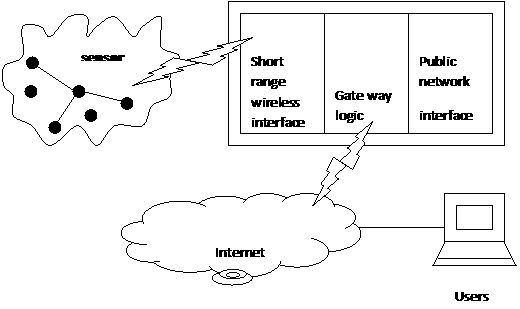





Published on Feb 14, 2025
The communications capability of devices and continuous transparent information routes are indispensable components of future oriented automation concepts. Communication is increasing rapidly in industrial environment even at field level.In any industry the process can be realized through sensors and can be controlled through actuators.
The process is monitored on the central control room by getting signals through a pair of wires from each field device in Distributed Control Systems (DCS). With advent in networking concept, the cost of wiring is saved by networking the field devices. But the latest trend is elimination of wires i.e., wireless networks.
Wireless sensor networks - networks of small devices equipped with sensors, microprocessor and wireless communication interfaces.In 1994, Ericsson Mobile communications, the global telecommunication company based in Sweden, initiated a study to investigate, the feasibility of a low power, low cost ratio interface, and to find a way to eliminate cables between devices. Finally, the engineers at the Ericsson named the new wireless technology as "Blue tooth" to honour the 10th century king if Denmark, Harald Blue tooth (940 to 985 A.D).
The goals of blue tooth are unification and harmony as well, specifically enabling different devices to communicate through a commonly accepted standard for wire less connectivity.
Blue tooth operates in the unlicensed ISM band at 2.4 GHZ frequency band and use frequency hopping spread spectrum technique. A typical Blue tooth device has a range of about 10 meters and can be extended to 100meters. Communication channels supports total bandwidth of 1 Mb / sec. A single connection supports a maximum asymmetric data transfer rate of 721 KBPS maximum of three channels.
In bluetooth, a Piconet is a collection of up to 8 devices that frequency hop together. Each Piconet has one master usually a device that initiated establishment of the Piconet, and up to 7 slave devices. Master's Blue tooth address is used for definition of the frequency hopping sequence. Slave devices use the master's clock to synchronize their clocks to be able to hop simultaneously.
When a device wants to establish a Piconet it has to perform inquiry to discover other Blue tooth devices in the range. Inquiry procedure is defined in such a way to ensure that two devices will after some time, visit the same frequency same time when that happens, required information is exchanged and devices can use paging procedure to establish connection.When more than 7 devices needs to communicate, there are two options.
The first one is to put one or more devices into the park state. Blue tooth defines three low power modes sniff, hold and park. When a device is in the park mode then it disassociates from and Piconet, but still maintains timing synchronization with it. The master of the Piconet periodically broadcasts beacons (Warning) to invite the slave to rejoin the Piconet or to allow the slave to request to rejoin. The slave can rejoin the Piconet only if there are less than seven slaves already in the Piconet. If not so, the master has to 'park' one of the active slaves first.
All these actions cause delay and for some applications it can be unacceptable for eg: process control applications, that requires immediate response from the command centre (central control room).Scatternet consists of several Piconets connected by devices participating in multiple Piconet.
These devices can be slaves in all Piconets or master in one Piconet and slave in other Piconets. Using scatternets higher throughput is available and multi-hop connections between devices in different Piconets are possible. i.e., The unit can communicate in one Piconet at time so they jump from pioneer to another depending upon the channel parameter.

The main challenge in front of Blue tooth developers now is to prove interoperability between different manufactures’ devices and to provide numerous interesting applications. One of such applications is a wireless sensor network.
Wireless sensor networks comprise number of small devices equipped with a sensing unit, microprocessors, and wireless communication interface and power source.
1. An important feature of wireless sensor networks is collaboration of network nodes during the task execution.
2. Another specific characteristics of wireless sensor network is Data-centric nature.
As deployment of smart sensor nodes is not planned in advance and positions of nodes in the field are not determined, it could happen that some sensor nodes end in such positions that they either cannot perform required measurement or the error probability is high. For that a redundant number of smart nodes is deployed in this field. These nodes then communicate, collaborate and share data, thus ensuring better results.
Smart sensor nodes scattered in the field, collect data and send it to users via “gateway” using multiple hop routes.
The main functions of a gateway are
Communication with sensor Networks
Shortage wireless communication is used.
It provides functions like discovery of smart sensor nodes, generic methods of sending and receiving data to and from sensors, routing.
Gateway logic
It controls gateway interfaces and data flow to and from sensor network.
It provides an abstraction level that describes the existing sensors and their characteristics.
It provides functions for uniform access to sensors regardless of their type, location or N/W topology, inject queries and tasks and collect replies.
Communication With Users
Gateway communications with users or other sensor networks over the Internet, WAN, Satellite or some shortage communication technology.
From the user point of view, querying and tasking are two main services provided by wireless sensor networks. Queries are used when user requires only the current value of the observed phenomenon. Tasking is a more complex operation and is used when a phenomenon has to be observed over a large period of time. Both queries and tasks of time to the network by the gateway, which also collects, replies and forwards them to users.
| Are you interested in this topic.Then mail to us immediately to get the full report.
email :- contactv2@gmail.com |